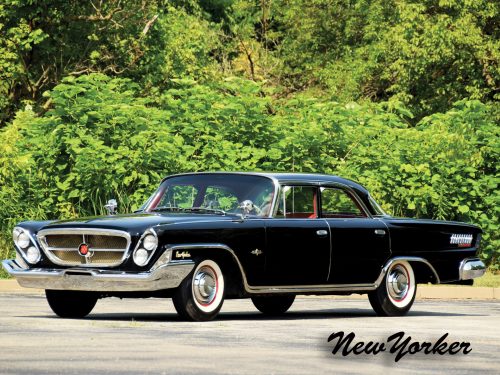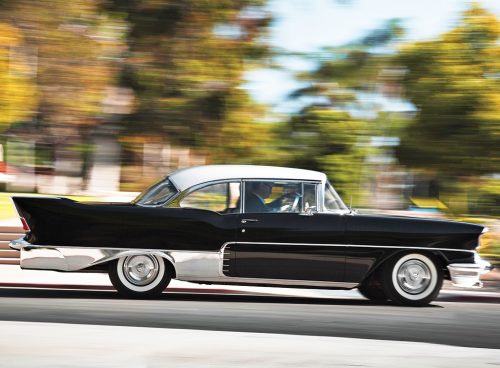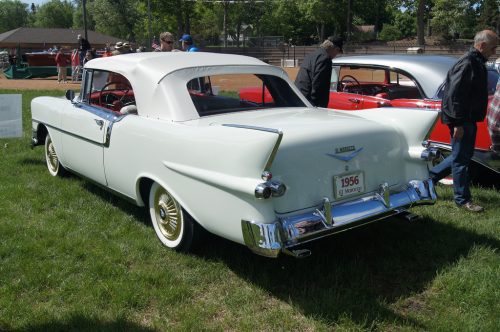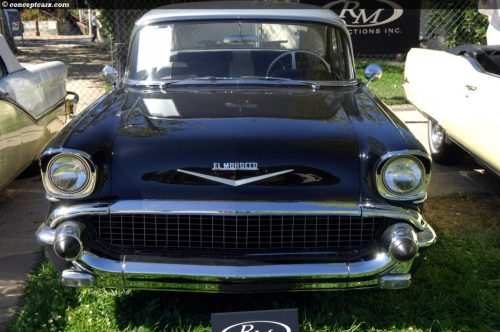Nos Amours, nos «Chars» 1962 Chrysler NewYorker

En temps qu’ éditeur, j’ai pris la liberté de surnommer cette grosse Chrysler noire « La Black Stallion ». Je vous explique un peux plus loin dans l’article. Imaginez que même la plaque d’immatriculation du Québec était noire avec lettrage blanc, comme si elle avait été conçue spécialement pour ce modèle.
Cette Chrysler New Yorker 1962 de Maurice Guilbault, de Sherbrooke, est une autre de ces voitures conservées dans une condition impeccable. Son propriétaire précédent s’assurait que la Stallion avait ses deux couches de Vista (une marque de cire) par année. Je suis certain que beaucoup se souviennent de la Vista en pâte, un contenant de couleur or.
C’est un citoyen de Sherbrooke, M. Clark qui en fut le premier propriétaire. Il en fit l’achat chez le concessionnaire MARTIN de Sherbrooke. Par le fait même, l’emblème est encore visible sur le véhicule localisé à l’arrière, coté du chauffeur au dessus du pare-choc. Son propriétaire rendit l’âme en 1964. C’est à ce moment que Gérard Guilbault en fit l’achat par l’entremise d’une Fiducie. I] la revendit à son neveu Maurice en 1978. Elle fait partie de la famille depuis 1965.
Sur la photo en couleur, on voit que cette berline est tout à fait resplendissante dans son originalité. Elle affichait seulement 76 000 milles (122 300 km ) au compteur à l’automne 1999. Depuis sa possession Maurice n’a eu qu’à remplacer les pneus et l’échappement.
Maintenant voici le moment de révélation de « La Black Stallion » : sous le capot un moteur de série V-8 de 413.3 p.c. d’une puissance de 340 chevaux, toute une (Tsime de Chevaux ) pour le vieux « mononcle » Gérard. Mais rassurez-vous cette voiture était la plus économique de sa catégorie. Lors des épreuves de la pétrolière américaine Mobil Gas, la New Yorker n’a consommé que 18 mi/gallon; pas trop gourmande pour une grosse cylindrée. C’était la première fois depuis 1938, qu’on ne retrouvait pas de deux portes dans la série New Yorker.

Une petite coïncidence : j’ai moi même possèdé une 1962 Chrysler Newport de couleur bleu ciel avec un 383 p.c. et des « Push Buttons » comme embrayage. C’était en 1978, elle était semblable à celle illustré sur cette photo.
Le Klaxon….BIP! BIP!
Gilles Boudreault
1956 - 1957 EL MOROCCO Great idea, but...

Back in the days when customs were cool and the Eldorado was everyone’s dream, there appeared a very special Chevy that wasn’t really a Chevrolet. Here’s the story of the low-price lookalike that’s even rarer and more coveted now than the Caddys it set out to imitate.
Question: When is a Chevrolet not a Chevrolet?
Answer: When it’s an El Morocco.
Ah, but wasn’t that just a customized Chevy? Not quite, because the name change was official, all nice and legal.
The story begins with one Ruben Allender, a millionaire Detroit industrialist and car enthusiast. In late 1955 he reckoned that a market existed for a low-priced lookalike of the Cadillac Eldorado convertible he’d just purchased, a car at the top of most everyone’s dream list. Aware of the customized craze then sweeping the nation, he decided to do what thousands were already doing: restyle a Chevrolet, only he would build copies to special order.

It was a great idea, and Allender was singularly well-equipped to pursue it. Besides having lots of money, he just happened to own a big war-surplus wharehouse in Detroit filled with leftover hardware that could be used to create his automotive illussion. It could even serve as a shop for making it. And he got a little unexpected help from General Motors, of all places, which made the ’56 Chevrolet look more like a Cadillac than the ’55 model he initially planned to use. Allender needed a prototype design, so he went to Creative Industries, an independent Detroit speciality styling and fabrication house that had built the Ford Atmos and Packard Panther show cars under contract.
Once a nearby agency agreed to supply factory-fresh Bel Airs at about $50 over dealer cost, the third floor of allender’s warehouse was cleared for converting everyday Chevys into imitation Caddys. But Allender didn’t stop there. Deciding that his cars should have their own name, he went looking for something that sounded a bit like “Eldorado”, but not so much as to invite trouble from Cadillac. Ultimately he picked “El Morocco” and managed to pull a few strings to get it recognized by the law.

Mechanically,the ’56 El Morocco left Allender’s shop just the way Chevy had built it. The styling, of course, was something else: engineered by Cyril Olbrich and professionally crafted, but as much a “junkyard jumble” as any of the Fifties custom. Many of the pieces came straight from Allender’s wharehouse. The prominent “Dagmar” front bumper guard, for example, were actually ’37 Dodge truck headlamp shells reinforced with fiberglass. The major changes naturally showed up at the rear. A portion of the Chevy fenders was cut away and Eldo-style fiberglass fins were bolted on, then finished with epoxy resin to create a smooth seam that would be invisible when painted. Completing the illusion were ’55 Dodge taillamps mounted horizontally above dummy exhaust ports. Allender had envisioned building up to 10 a day, but only 20 of the ‘56s were completed, two hardtop coupes and 18 convertibles. Most were fitted with a continental kit in true fifties style, which brought the advertised retail price up to around $3400. And that, of course, was the problem. While the El Morocco cost only half as much as an Eldorado, it was expensive for a Chevy, about $1000 more than the stock ’56, which was a lot of money in those days. Also working condition were so crude they had to run an extension cord up from the first floor, on the outside of the building, to get power to the shop.
For 1957, only a few more El Moroccos, probably no more than 16, or so were completed before production ended in mid-1957. Again the modifications were beautifully executed and centered mainly on the rear, but they were now done in metal on the mid-range Two-Ten two and four-door hardtops as well as the topline Bel Air convertible. While at least one of the latter was built, most of the ’57 were seen as four-door jobs.



Conversion began when the stock car is stripped of all trim and the trim mounting holes are filled in. Then the hood is completely smoothed out with extra sheet metal, welded in place and fender fins are also welded. All other trim is special [and expensive] cast or shaped aluminum or steel. All trims items are chromed. The Eldorado-like latticework grille is aluminum. The generous chrome rear-quarter side panels are dimpled sheet brass, which is chromed. Similar material is used in back at each side of the license plate recess. The two small lights in each rear chrome panel are dummies. As a finishing touch, the Chevrolet script above the gold V’s on hood and rear deck was replaced by “El Morocco” in neat block letters. All the ‘57s were apparently equipped with the four-barrel version of Chevy’s new 283 V-8, plus Powerglide automatic, radio and heater. Howerver, buyers could choose from turbine-type or triple-spoke “spinner” wheel covers. One final, fascinating distinction was a leather pad on the steering wheel hub. Deeply stamped into it were the words “El Morocco Custom Built For …,”with the owner’s name added later, of course.
Remarkably, the price difference between Chevy and El Morocco was much lower in ’57 than the previous year. The hardtops retailed at $2750-$2800, about $500 above the stock Two-Tens, while the convertible cost $2950, less than $500 more than the equivalent Bel Air. But by then, it was to late. hough Allender had hoped to sell El Morocco through selected Chevy dealers, the plan fizzled, perhaps due to lack of official GM backing. Moreover, his wharehouse facilities offered no hope of increasing production to a rofitable level,and demand for medium-price cars was on the wane anyway. Fortunately, a few of his cars still survive and still prompt doubletakes. They’re perhaps the rarest and most distinctive artifacts of the “Classis Chevy” years. They’re also a reminder that success in the auto business, then and now, takes a lot more than just a great idea.
Extracted from “Collectible Automobile” magazine of 1986
Par Maurice Joanisse
1955 CHRYSLER FALCON

La voiture de concept “Falcon” par Chrysler en 1955 est le plus près que Chrysler est venue de produire une voiture sport deux places jusqu’à l’arrivée de la Viper en 1992.
Elle a été décrite comme la Viper d’Exner. C’était un cabriolet sport deux places avec un long capot et plateforme arrière courte. Noté pour ses formes d’auto pures comme sa calandre proéminente et des tuyaux d’échappement exposés de côté. La calandre, genre caisse d’oeuf en forme de coeur du Falcon a été, plus tard, adaptée pour les 1957-59 Chrysler 300s, pendant que ses pots d’échappement montés par le côté ont été adoptés par le Dodge Viper de 1992.

La voiture de concept deux places Falcon de Chrysler en 1955, était le plus proche que Chrysler est venu à une voiture sport classique jusqu’à ce qu’il ait introduit la Dodge Viper en 1992. Beaucoup croient encore que la voiture de concept Falcon de Chrysler en 1955 était un spécial d’Exner qui devrait avoir été construit pour la vente. Enfin, lorsqu’elle a apparu, Ford avait déjà introduit la Thunderbird 1955 et les ventes de “Highland Park” se rétablissaient vite; donc une réponse d’un Mopar tant à la Corvette qu’à la Thunderbird aurait été tout à fait de mise.
Chrysler doit avoir pensé ainsi, aussi, car trois Falcons ont été construits par le “Studio de Forme” chez Chrysler. Bien qu’ils aient différé un peu par les détails, tous ont été montés sur un empattement de 105 pouces, comparable au 102 pouces de la Corvette et la Thunderbird. Il est connu que seulement un a survécu.
La forme, très jolie, était principalement le travail de Maury Baldwin et semble bonne encore aujourd’hui, surtout la grande calandre genre caisse d’oeuf en forme de coeur et les pots d’échappement de côté. Même les nageoires, à la mode dans des années ‘50 et le pare-brise courbé ne semblent pas particulièrement datés.



Ces manières routières étaient censément impeccables; au moins la performance était adéquate. Le Falcon avait un moteur Hemi produisant 170 chevaux-vapeurs tout comme l’Aventurer I de DeSoto, mais il a évité la transmission ” à torsion liquide” semi-automatique pour favoriser la PowerFlite complètement automatique, avec une baguette, trop légère, montée au plancher. Le trait le plus remarquable du Falcon se trouve sous la carrosserie de la voiture : construction monocoque avec un cadre de plate-forme cellulaire. Bien que le Falcon attire le regard sur les grands boulevards chics, il a aussi été reconnu comme une voiture puissante. Lors d’un essai routier, un temps de 10 secondes a été enregistré pour l’épreuve de 0-60 milles à l’heure. Le quart de mille a été accompli en 17.5 secondes avec une vitesse établie de 115 milles à 24 l’heure, des données qui sont plus qu’adéquates pour 1955. La consommation de cette voiture était d’environ 15 milles par gallon.
La construction d’acier monocoque laissait prévoir les orientations futures chez Chrysler. Le poids de restriction, assez imposant, était de 3 300 livres. Le toit du cabriolet était manuel et pouvait être rangé sous un couvercle pliant localisé derrière le siège. En dépit de son poids, le Falcon était admirablement équilibré. La maniabilité facile et précise était un atout pratiquement inconnu à cette période, surtout pour les produits Chrysler. Le désavantage réel de cette voiture était le manque de hauteur en raison de son pare-brise très bas lorsque le toit était levé, bien que cela aurait pu être modifié pour la production.



Ce qui, évidemment, n’est pas arrivé. Bien que le Falcon aurait pu devenir un fort concurrent pour la Corvette et la Thunderbird, avec un rafinement et une performance supérieur, il était condamné par le minuscule marché de voitures sports de cette époque. Aussi, Chrysler a probablement estimé qu’il n’avait pas vraiment besoin d’une telle voiture puisque les ventes totales étaient bonnes – ce qui n’étaient plus le cas après 1957. Dommage. Aurait-elle connue la popularité de la Corvette comme voiture sport? Si oui, la venue de la Viper aurait-elle été compromise? Aurait-elle suivi la voie de la Thunderbird, soit devenir plus luxueuse que sportive, pour enfin disparaître?
Source: Chrysler Design Institute
Par Maurice Joanisse
1952 Chevrolet Deluxe


